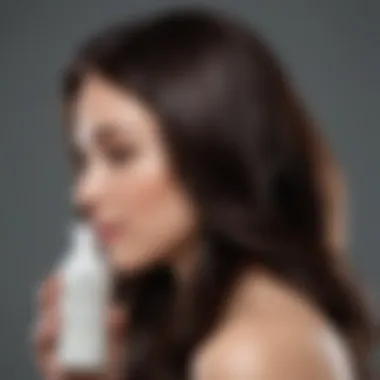A Comprehensive Analysis of Hair Conditioner Brands


Intro
In the world of hair care, conditioners play a pivotal role in ensuring that hair remains healthy, manageable, and vibrant. With a multitude of brands available, understanding which product works best for one's specific hair type is essential. This article explores various hair conditioner brands, their distinct formulations, and how they can impact an individual's hair care routine.
Through thorough research, we will analyze the ingredients, customer feedback, and brand histories. This deep dive aims to provide readers with the necessary insights to make informed decisions on conditioners that cater to their unique hair needs.
Fashion Trends
The popularity of hair conditioners intersects with broader fashion trends. Many brands have begun to integrate sustainability and style into their product lineups, reflecting consumer demand for ethical beauty products.
Street Style Inspiration
Modern hair care brands often draw inspiration from street style. Conditioners are not just functional; they are marketed as part of a lifestyle that emphasizes individuality. Consumers look for products that resonate with their personal style, leading brands to create diverse options.
Sustainable Fashion
Sustainable practices are increasingly relevant in hair care. Brands like Oway and Lush prioritize eco-friendly formulations and packaging. Their conditioners often use natural ingredients and recyclable materials, aligning with growing consumer concerns regarding environmental impact. This trend can influence buyers' choices, as consumers often prefer brands that reflect their values.
Beauty Tips
The right conditioner can significantly enhance hair appearance and health. Understanding how to choose one suited to specific hair types is essential.
Hair Care and Styling
When selecting a hair conditioner, things to consider include:
- Hair type: Different conditioners cater to straight, curly, or wavy hair.
- Formulation: Look for ingredients such as shea butter for moisture or Arnica for scalp health.
- pH balance: A balanced pH can protect the hair cuticle.
Incorporating conditioners into a styling routine can lead to better results, allowing for easier styling and improved overall health of the hair.
Product Reviews
Product reviews inform consumers about the effectiveness of different brands. It is imperative to assess various products before making a purchase.
Brand Spotlights
Some notable brands include Pantene, Moroccanoil, and Aussie. Each has unique selling points and a loyal customer base. Examining these can provide clarity about what to expect from each brand.
"Choosing the right conditioner is vital for maintaining the hair's health and style. With myriad options, it can be overwhelming but rewarding."
Prologue to Hair Conditioner Brands
Hair conditioners play a crucial role in the hair care routine for many individuals. This section aims to provide essential insights into hair conditioner brands, showcasing their significance and the nuances involved in choosing the right one. The vast array of products available can be overwhelming, making it imperative to understand what distinguishes each brand.
Understanding Hair Conditioner
Hair conditioners are formulated to improve the texture and manageability of hair. While shampoo cleanses hair, conditioner replenishes moisture and adds a protective layer. Understanding its composition is vital. Conditioners often contain a mix of humectants, emollients, and film-forming agents. These elements work together to hydrate hair and reduce frizz. Key ingredients such as silicones can provide shine and slip, while proteins can strengthen the hair shaft. Knowing how these ingredients work helps users select products that best suit their hair type and needs.
The Role of Conditioners in Hair Care
Conditioners are not merely a supplementary step; they are essential for maintaining healthy hair. They help to detangle strands, making them easier to comb. Furthermore, conditioners can enhance the appearance of hair, giving it a polished look. Regular use fosters better moisture retention and can improve overall hair health.
"The right conditioner can transform the texture and appearance of hair, making it a vital product in personal care."
Moreover, different hair types require different conditioning solutions. Curly hair, for instance, often benefits from heavier creams that provide extra hydration. In contrast, fine hair might require lightweight conditioners that do not weigh the hair down. Understanding these distinctions can lead to more effective hair care and improved consumer satisfaction.
The landscape of hair conditioners is diverse, and awareness of various brands can provide users with tailored choices based on their unique hair properties and lifestyle needs.
Popular Hair Conditioner Brands
Understanding the popular hair conditioner brands is essential for anyone seeking effective hair care solutions. These brands play a significant role in defining trends, setting standards in formulations, and influencing consumer preferences. When consumers think about hair conditioning products, they often refer to well-known names, as these brands have established a sense of trust and reliability in their products. In this section, we will explore key players in the market as well as newer entrants that are carving their niche.
Overview of Market Leaders
The leading hair conditioner brands have a well-documented history of success and innovation. Some of these market giants include L'Oréal Paris, Pantene, Dove, and Olaplex. Each of these brands has tailored their products to address an array of hair types and conditions.


- L'Oréal Paris: Known for its extensive range of hair care products, L'Oréal continues to deliver conditioners that cater to specific needs such as damage repair, dry hair hydration, and more.
- Pantene: This brand has built a reputation for promoting healthy hair and often emphasizes the importance of using the complete hair care system, including conditioners.
- Dove: Dove is distinguished for its commitment to real beauty and aims to provide various conditioners that support this vision, targeting a wide audience.
- Olaplex: This brand focuses on bond-building technology to repair hair from within. It gained quick popularity due to its effectiveness in treating damaged hair.
These brands have broad distribution, making their products easily accessible in various retail channels. Their advertising strategies also educate consumers on the benefits of their products, enhancing consumer understanding and trust.
Emerging Brands on the Scene
In addition to established leaders, several emerging brands are making waves in the hair conditioner market. These brands often focus on niche segments, offering unique formulations that appeal to specific demographics or hair concerns.
- Moroccanoil: This brand primarily emphasizes the use of argan oil. It is marketed towards those looking for nourishing products that enhance shine and softness.
- SheaMoisture: Focused on natural ingredients, SheaMoisture appeals to consumers looking for organic and ethical hair care solutions, especially for textured hair.
- Function of Beauty: A customizable brand, it tailors products to individual hair needs. Consumers can choose formulations based on their specific hair type and concerns.
These newer entries often prioritize sustainability and ethical sourcing, appealing to the growing market segment that values environmentally-friendly products.
Brand Profiles
Understanding the specific profiles of hair conditioner brands is crucial in this analysis. Each brand has distinct characteristics, formulations, and target audiences. By examining these profiles, consumers can gain insights into which products may best meet their hair care needs. This section will shed light on how each brand positions itself in the market and how its offerings address specific consumer demands.
'Oréal Paris
Product Range
L'Oréal Paris offers a broad product range tailored to various hair types and concerns. The inclusivity of their range caters to users looking for solutions from hydration to damage repair. A key characteristic of their product line is the emphasis on diverse formulations, such as their Elvive series, targeting specific issues like frizz control or color protection. However, while the variety is commendable, some users may find the sheer number of options overwhelming.
Target Consumer
L'Oréal Paris typically targets a wide demographic, appealing to both budget-conscious consumers and those looking for premium solutions. The brand's strong presence in mass retail ensures accessibility. Its diverse marketing campaigns attract a variety of consumers, which makes it a familiar choice for many. Nonetheless, some consumers may perceive the brand as too commercial, overshadowing its product efficacy.
Key Ingredients
The brand is known for incorporating advanced ingredients, like argan oil and coconut oil, in its formulas. These ingredients are beneficial for nourishing and repairing hair, providing hydration and gloss. The focus on such high-quality ingredients sets L'Oréal Paris apart in the market. However, it is essential for users to consider potential sensitivities to certain synthetic additives used in their products.
Pantene
Historical Context
Pantene has a long-standing history in the hair care industry, dating back to its inception in the 1940s. Its reputation was built on innovative formulae that promoted healthy hair. The historical context of Pantene plays a foundational role in its brand identity and consumer trust, as many users have grown up using its products. This legacy can be a powerful asset in retaining loyal customers.
Brand Innovations
Pantene has consistently introduced new technology and innovations, such as the Pro-V formula. This aligns with their goal of delivering professional-quality results at home. Innovations like these have garnered consumer attention and contributed positively to brand loyalty. However, while innovations are helpful, they also require ongoing commitment from the brand to ensure they meet consumer expectations over time.
Consumer Response
Consumer response to Pantene is generally favorable, with many praising the effectiveness of its products in improving hair health. However, some users criticize the chemical formulation, suggesting that it may not suit everyone. This mix of positive feedback and valid concerns illustrates the need for consumers to assess their own hair type before choosing a product.
Dove
Philosophy
Dove promotes a philosophy centered on self-acceptance and natural beauty. Their core message resonantes with many consumers who appreciate the body-positive approach. This philosophy differentiates Dove from competitors, making it appealing for those seeking more than just functional benefits in their conditioner. On the flip side, the marketing narrative might not focus heavily enough on technical benefits for users interested in performance.
Product Lines
Dove offers various product lines, including conditioner types specifically formulated for damage repair and hydration. Their deep moisture line is particularly popular. These products highlight Dove's commitment to nourishing pysical need as well as emotional appeal. However, consumers may seek additional innovations beyond the classic moisturizing formulas.
Market Positioning
Dove's market positioning is characterized by its strong emphasis on emotional connections with consumers. The focus on personal beauty and self-esteem attracts a demographic focused less on luxury and more on caring for themselves. Nonetheless, the brand must continue to innovate to stay relevant in a market that often emphasizes trending ingredients and technologies.
Olaplex
Signature Products
Olaplex is particularly known for its signature products that focus on bond-building technology, offering unique solutions for damaged hair. This approach sets it apart in a crowded market. The unique formulations are scientifically-driven, which appeals to consumers seeking effective, repair-focused options. Yet, the price point may deter budget-conscious shoppers.
Treatment Approach
The treatment approach utilized by Olaplex centers on repairing the internal structure of the hair rather than simply coating it. This method appeals to professionals and consumers dedicated to hair health. Although claimed benefits are often backed by scientific credibility, results may vary among users, leading to mixed experiences.


Brand Loyalty
Olaplex has cultivated strong brand loyalty due to its innovative products and notable results among users. The community-driven effect, especially among hairstylists, enhances its reputation. However, as competitor brands evolve with similar offerings, maintaining this loyalty will require ongoing product improvement and effective marketing strategies.
Moroccanoil
Oil-Benefit Focus
Moroccanoil places significant emphasis on the use of argan oil, known for its deep moisturizing properties. This focus appeals to consumers looking for nourishing and hydrating solutions. Their products enhance shine and manageability, addressing core issues for many users. However, the heavier oil formulation may not be ideal for all hair types, potentially leading to user dissatisfaction.
Brand Identity
Moroccanoil's brand identity is beautifully crafted around luxury and high-quality ingredients. The brand effectively communicates its commitment to premium hair care, attracting discerning consumers. Yet, the positioning as a luxury product may leave some feeling excluded based on price.
Target Demographic
Moroccanoil typically targets individuals who prioritize high-quality hair care and are willing to invest in premium products. This demographic often seeks effective solutions for finer hair textures that require nourishing care without weighing it down. However, the higher price range can limit accessibility for wider audiences.
Ingredient Analysis
Ingredient analysis plays a pivotal role in understanding hair conditioners. It allows consumers to make informed decisions based on their specific hair needs. Different ingredients in conditioners target various hair issues, from dryness to damage. This section will dissect the key components used in hair conditioners, focusing on their benefits and considerations. The right ingredients can enhance the effectiveness of a conditioner, improving overall hair health.
Common Conditioning Agents
Common conditioning agents are the foundation of most hair conditioners. These ingredients help to smooth hair, reduce frizz, and add shine. Some widely recognized conditioning agents include:
- Cationic Surfactants: These positively charged molecules attach to the negatively charged hair strands, providing a slip that makes hair easier to comb.
- Silicones: These provide a protective layer that adds shine and reduces moisture loss. Notable silicones include dimethicone and cyclopentasiloxane.
- Fatty Alcohols: Ingredients like cetyl and stearyl alcohol serve as emollients, adding moisture and improving texture without the greasy feel.
Understanding these common agents can help consumers choose products that align with their hair type and styling goals.
Natural vs. Synthetic Ingredients
The debate between natural and synthetic ingredients is an ongoing discussion in the hair care industry. Natural ingredients often appeal to consumers who prioritize sustainability and skin sensitivity. They include botanical extracts, essential oils, and naturally derived proteins. However, synthetic ingredients can provide targeted benefits that natural ones may not achieve. For example, synthetic polymers can help to hold styles and prevent humidity-induced frizz effectively.
"The choice between natural and synthetic ingredients may depend on personal preference, hair type, and specific hair care goals."
It is essential for consumers to evaluate their priorities, whether they lean towards eco-friendliness or the quest for efficacy.
Fragrance and Preservatives
Fragrance and preservatives are crucial aspects that contribute to a product's sensory experience and shelf stability. Many conditioners use synthetic fragrances to create appealing scents that enhance the hair washing experience. However, some consumers may prefer products with natural fragrances to avoid potential irritants. Common preservatives, such as parabens, are used to prevent microbial growth, which is essential for the product's longevity.
- Fragrances: Often added to improve user experience, fragrances should be chosen with care. Some may find they have sensitivities to certain scents.
- Preservatives: Understanding the role of preservatives like phenoxyethanol can help mitigate concerns about product safety.
Conscious selection of fragrances and preservatives can help consumers align their choices with their values, whether they lean towards safety, efficacy, or environmental consciousness.
Target Audiences of Hair Conditioner Brands
Understanding the target audiences for hair conditioner brands is crucial in comprehending how these products are designed and marketed. Each audience has unique hair care needs based on hair type, texture, and specific concerns. Brands that successfully identify and cater to these needs can create products that resonate with consumers. This alignment often translates to higher satisfaction and brand loyalty.
Conditioners for Curly Hair
Curly hair requires special treatment due to its texture and the way it dries. People with curly hair often seek conditioners that provide deep moisture and reduce frizz. Formulations containing ingredients like shea butter, coconut oil, and jojoba oil are popular. These ingredients help to hydrate and define curls without weighing them down.
Consumers in this segment typically look for products labeled as "moisturizing" or "curl-defining". Market research indicates that these individuals are often willing to invest in products that maintain the health and shape of their curls. Hence, brands like DevaCurl and Ouidad have gained popularity for their specific approach to curl care.
Products for Colored Hair
Colored hair needs conditioners that not only hydrate but also protect the vibrancy of the color. Individuals who dye their hair may face challenges such as dryness and fading color. Thus, conditioners designed for color-treated hair often contain UV filters and ingredients that seal moisture.
For this audience, brands such as Redken and Herbal Essences offer specific products that cater to their needs. These products often boast features like "sulfate-free" to ensure that the color lasts longer and looks vibrant. Additionally, these consumers prefer to read labels closely, looking for formulations that promise both care and protection.
Conditioners for Fine and Oily Hair
Fine or oily hair presents its own set of challenges. Consumers typically seek lightweight conditioners that do not weigh their hair down. Ingredients like aloe vera and green tea extract can help to nourish hair without adding excessive oil.


These individuals often look for products labeled as "volumizing" or "lightweight". Furthermore, brands like Bumble and Bumble and L'Oréal Paris have successfully targeted this audience with products that offer sufficient moisture without compromising volume. It is essential for hair conditioners in this category to balance hydration while maintaining hair health.
Each hair type has specific needs. Aligning product formulations with these needs is key to brand success.
Sustainability in Hair Conditioner Brands
Sustainability has become a critical aspect of the beauty industry, influencing consumer choices and corporate strategies. In the realm of hair conditioners, sustainability encompasses various factors including ingredient sourcing, production methods, packaging, and overall environmental impact. As consumers grow more aware of their ecological footprints, they tend to favor brands that prioritize sustainable practices. This trend reflects a broader push towards responsible consumption and greater corporate accountability.
Companies that engage in sustainable practices often experience a stronger brand loyalty. This is because sustainable options not only attract eco-conscious consumers but also create a positive image. Brands can enhance their credibility by transparently sharing their methods of production and material sourcing. Therefore, embracing sustainability is crucial for a brand’s long-term growth in today’s market.
Eco-Friendly Practices
Eco-friendly practices are at the forefront of many successful hair conditioner brands. These practices vary widely but generally include reducing waste, utilizing renewable energy, and improving supply chain transparency.
Some of the key eco-friendly practices include:
- Biodegradable Packaging: Many brands are shifting away from conventional plastic and opting for compostable or recyclable materials to decrease waste in landfills.
- Water Conservation: Companies can reduce water usage in production and advocate for consumers to do the same by offering concentrated formulas that require less water in formulation.
- Ethical Supply Chains: These practices ensure that raw materials are sourced responsibly, often involving fair wages for farmers and promoting biodiversity.
These strategies not only minimize environmental impact but also appeal to a demographic that increasingly thinks about the consequences of their purchases.
Sustainable Ingredients and Sourcing
The ingredients in hair conditioners play a significant role in determining their sustainability. Brands are increasingly aware of the need to incorporate sustainable ingredients into their formulations. Sustainable ingredients are sourced in a way that protects ecosystems and ensures fair practices.
When examining sustainable ingredients, consider the following:
- Natural vs. Synthetic: Many consumers prefer natural ingredients such as shea butter, coconut oil, and essential oils, which tend to have a lower environmental footprint than synthetic alternatives.
- Sourcing Practices: Brands that partner with local farmers or sustainable suppliers are often seen as more responsible. By ensuring that ingredients are grown without harmful pesticides or excessive water use, they contribute positively to the environment.
- Transparency: Offering consumers full disclosure about where and how ingredients are sourced promotes trust. Customers want to know if brands uphold ethical standards when choosing their ingredients.
The movement towards sustainable ingredients is not just a trend; it is a response to increasing consumer demand for products that are both effective and environmentally friendly. By prioritizing sustainability, hair conditioner brands can capture a more conscientious market.
Consumer Trends and Preferences
Understanding consumer trends and preferences is vital in the context of hair conditioner brands. Trends influence how products are marketed and can dictate what consumers prioritize when selecting their hair care items. In recent years, trends in wellness, sustainability, and personalization have transformed the hair care landscape. Analyzing these trends provides valuable insights into the expectations and behaviors of consumers today.
Shifts in Buying Behavior
The buying behavior of consumers has evolved significantly in recent years. One major shift is the increasing inclination towards online shopping. Consumers now prefer the convenience of purchasing hair conditioners from the comfort of their homes. This trend has led to the rise of brands establishing strong online presences, which include detailed product information and user reviews, fostering informed purchasing decisions.
Another notable change is the growing awareness toward ingredients. Consumers are now more educated and critical about what goes into their hair care products. Many prefer brands that transparently share their ingredient lists. This shift often drives shoppers toward products with natural and organic ingredients, reflecting a broader movement within personal care industries to align with consumer values of health and safety.
Influence of Social Media
Social media continues to shape consumer preferences in remarkable ways. Platforms such as Instagram and TikTok have given rise to beauty influencers, who often showcase their hair care routines and recommend specific products. These endorsements can significantly impact consumer choices, creating trends that lead to specific conditioner brands gaining life-long customers.
Moreover, social media acts as a shared platform for consumer experiences. Many users post before-and-after photos, testimonials, and product reviews, which can greatly affect the perceptions of potential buyers. The interactive nature of social media also encourages brands to engage directly with their target audience, allowing for real-time feedback and quick adjustments to product offerings.
"In the world of hair care, understanding what consumers seek not only positions brands strategically but also fosters a community of informed shoppers."
This dual impact of shifts in buying behavior and the influence of social media signals a dynamic landscape. Brands that adapt to these trends can connect better with consumers, ultimately impacting their market success. For women of all ages, recognizing these trends can empower them to make educated choices in their hair care products.
Epilogue
The conclusion of this article emphasizes the critical role of hair conditioner brands in individual hair care routines. A well-chosen conditioner can profoundly affect hair health, shine, and manageability. Given the vast landscape of options available, consumers must consider several factors when selecting a product.
First, understanding the specific needs of their hair types is essential. For instance, a conditioner designed for curly hair may focus on moisture retention and frizz control, whereas products targeting fine hair might prioritize volumizing properties. Getting familiar with key ingredients and formulations enhances a consumer's ability to make knowledgeable decisions.
Moreover, in an increasingly competitive market, it's insightful to evaluate brand reputations and customer reviews. Many brands invest in research and development to improve their formulations continuously, aiming to better serve their target consumers. Understanding these elements allows readers to navigate the abundance of choices effectively.
"A conditioner is not merely a cosmetic product; it embodies the principles of individualized care for diverse hair types."
Ultimately, the selection process should align with personal preferences, lifestyle, and any specific hair concerns.
Summary of Key Insights
Throughout this comprehensive analysis, we explored several critical insights regarding hair conditioner brands:
- Variety of Options: There is an extensive range of brands catering to various hair types and concerns.
- Ingredient Awareness: Knowledge about common conditioning agents versus natural or synthetic ingredients guides educated choices.
- Emerging Trends: Sustainability and eco-friendly practices are gaining traction among consumers.
Future of Hair Conditioner Brands
Looking ahead, the future of hair conditioner brands seems promising and dynamic. Trends indicate a shift toward personalized products that cater to individual hair needs. Technology in hair care is likely to evolve, allowing brands to offer customized formulations based on hair diagnostics.
Additionally, the growing awareness of sustainability may push brands to incorporate greener practices in sourcing and packaging. As consumers become more conscious of their choices, brands will need to adapt to these expectations. The integration of technology and eco-consciousness will likely shape the hair care landscape in the coming years.



